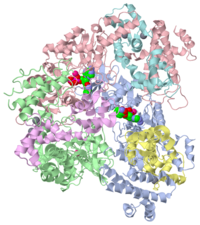User:Charlotte Kern/Sandbox 702
From Proteopedia
(New page: 200px {{STRUCTURE_1lvc| PDB=1lvc | SCENE= }} ===Ceci est un test, j'ai juste copié/collé la page générée automatiquement=== ===Crystal structure of the...) |
|||
| Line 3: | Line 3: | ||
{{STRUCTURE_1lvc| PDB=1lvc | SCENE= }} | {{STRUCTURE_1lvc| PDB=1lvc | SCENE= }} | ||
| - | + | Anthrax edema factor (EF) is an enzyme which is part of the Bacillus anthracis anthrax toxin. The anthrax toxin is composed of a cell-binding protein (protective antigen) (PA), lethal factor (LF) and edema factor (EF).<ref>Fouet, A. 2009. The surface of Bacillus anthracis. Mol. Aspects Med. 30:374–385</ref> <ref>Moayeri, M., and S. H. Leppla. 2009. Cellular and systemic effects of anthrax lethal toxin and edema toxin. Mol. Aspects Med. 30:439–455</ref> | |
| + | |||
| + | The edema factor is a calcium- and calmodulin-dependent adenylate cyclase. It causes the cellular level of cAMP to increase thus upsetting water homeostasis and causing disruption of signaling pathways. | ||
| + | |||
| + | Here we study 1lvc – EF adenylate cyclase domain + calmodulin + anthraniloyl-deoxy-ATP. | ||
| + | EF adenylyl cyclase activity is induced by complexation with calmodulin, so it is allosterically activated by its presence. Calmodulin is ubiquitous eukaryotic cellular protein and a Ca2+ ion sensor present in host cells. | ||
| + | |||
===Crystal structure of the adenylyl cyclase domain of anthrax edema factor (EF) in complex with calmodulin and 2' deoxy, 3' anthraniloyl ATP=== | ===Crystal structure of the adenylyl cyclase domain of anthrax edema factor (EF) in complex with calmodulin and 2' deoxy, 3' anthraniloyl ATP=== | ||
| Line 18: | Line 24: | ||
==Reference== | ==Reference== | ||
| - | + | {{reflist}} | |
[[Category: Adenylate cyclase]] | [[Category: Adenylate cyclase]] | ||
[[Category: Bacillus anthracis]] | [[Category: Bacillus anthracis]] | ||
Revision as of 23:09, 5 January 2013
| |||||||||
| 1lvc, resolution 3.60Å () | |||||||||
|---|---|---|---|---|---|---|---|---|---|
| Ligands: | , , | ||||||||
| Activity: | Adenylate cyclase, with EC number 4.6.1.1 | ||||||||
| Related: | 1k90 | ||||||||
| |||||||||
| |||||||||
| Resources: | FirstGlance, OCA, PDBsum, RCSB | ||||||||
| Coordinates: | save as pdb, mmCIF, xml | ||||||||
Anthrax edema factor (EF) is an enzyme which is part of the Bacillus anthracis anthrax toxin. The anthrax toxin is composed of a cell-binding protein (protective antigen) (PA), lethal factor (LF) and edema factor (EF).[1] [2]
The edema factor is a calcium- and calmodulin-dependent adenylate cyclase. It causes the cellular level of cAMP to increase thus upsetting water homeostasis and causing disruption of signaling pathways.
Here we study 1lvc – EF adenylate cyclase domain + calmodulin + anthraniloyl-deoxy-ATP. EF adenylyl cyclase activity is induced by complexation with calmodulin, so it is allosterically activated by its presence. Calmodulin is ubiquitous eukaryotic cellular protein and a Ca2+ ion sensor present in host cells.
Contents |
Crystal structure of the adenylyl cyclase domain of anthrax edema factor (EF) in complex with calmodulin and 2' deoxy, 3' anthraniloyl ATP
Edema factor (EF) and CyaA are calmodulin (CaM)-activated adenylyl cyclase exotoxins involved in the pathogenesis of anthrax and whooping cough, respectively. Using spectroscopic, enzyme kinetic and surface plasmon resonance spectroscopy analyses, we show that low Ca(2+) concentrations increase the affinity of CaM for EF and CyaA causing their activation, but higher Ca(2+) concentrations directly inhibit catalysis. Both events occur in a physiologically relevant range of Ca(2+) concentrations. Despite the similarity in Ca(2+) sensitivity, EF and CyaA have substantial differences in CaM binding and activation. CyaA has 100-fold higher affinity for CaM than EF. CaM has N- and C-terminal globular domains, each binding two Ca(2+) ions. CyaA can be fully activated by CaM mutants with one defective C-terminal Ca(2+)-binding site or by either terminal domain of CaM while EF cannot. EF consists of a catalytic core and a helical domain, and both are required for CaM activation of EF. Mutations that decrease the interaction of the helical domain with the catalytic core create an enzyme with higher sensitivity to Ca(2+)-CaM activation. However, CyaA is fully activated by CaM without the domain corresponding to the helical domain of EF.
Physiological calcium concentrations regulate calmodulin binding and catalysis of adenylyl cyclase exotoxins., Shen Y, Lee YS, Soelaiman S, Bergson P, Lu D, Chen A, Beckingham K, Grabarek Z, Mrksich M, Tang WJ, EMBO J. 2002 Dec 16;21(24):6721-32. PMID:12485993
From MEDLINE®/PubMed®, a database of the U.S. National Library of Medicine.
About this Structure
1lvc is a 6 chain structure with sequence from Bacillus anthracis and Homo sapiens. Full crystallographic information is available from OCA.


